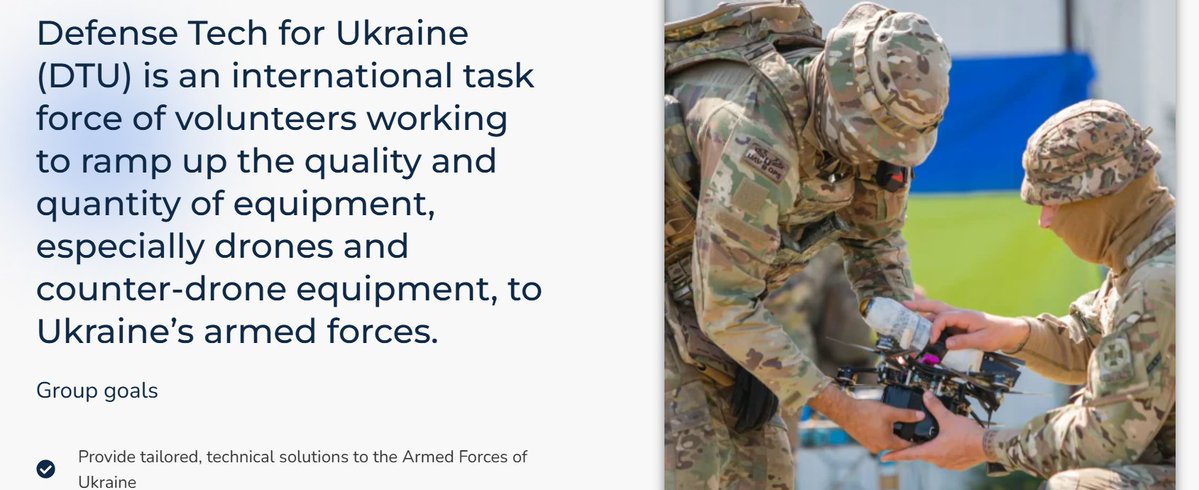🧵1/ While governments debated, a team of 150 engineers and volunteers quietly helped Ukraine outpace Russia’s battlefield tech — delivering life-saving tools in weeks, not years.
Meet Defense Tech for Ukraine (DTU) — a grassroots defense innovation group.👇
Meet Defense Tech for Ukraine (DTU) — a grassroots defense innovation group.👇

2/ DTU isn't a traditional defense contractor.
It's a distributed network of engineers, veterans, and frontline soldiers who collaborate remotely to solve real battlefield problems — quickly.
It's a distributed network of engineers, veterans, and frontline soldiers who collaborate remotely to solve real battlefield problems — quickly.

3/ What have they delivered?
📡 Fiber-optic drones immune to jamming
🕸️ Netgun quadcopters to disable enemy drones
📻 $10K radar systems rivaling $10M platforms
All developed outside traditional procurement pipelines.
📡 Fiber-optic drones immune to jamming
🕸️ Netgun quadcopters to disable enemy drones
📻 $10K radar systems rivaling $10M platforms
All developed outside traditional procurement pipelines.

4/ The model: skip the bureaucracy, focus on speed.
Six weekly syncs connect engineers with soldiers in real time. Field feedback helps refine tools fast — often from concept to combat within a month.
Six weekly syncs connect engineers with soldiers in real time. Field feedback helps refine tools fast — often from concept to combat within a month.

5/ One major breakthrough?
🧵Fiber-optic drones. GPS jamming is widespread, but these drones use physical cables to transmit high-definition video — maintaining reliable comms where wireless fails.
🧵Fiber-optic drones. GPS jamming is widespread, but these drones use physical cables to transmit high-definition video — maintaining reliable comms where wireless fails.

6/ The idea came from a U.S. Marine vet.
DTU helped develop it, test it in Ukraine, and open-source the design. Now, it’s widely adopted across frontline units.
DTU helped develop it, test it in Ukraine, and open-source the design. Now, it’s widely adopted across frontline units.

7/ Russia has responded with its own version — the Knyaz Vandal (KVN) drone.
It boasts longer cable runs and a 95% hit rate. It has already been used to destroy high-value targets behind the front.
It boasts longer cable runs and a 95% hit rate. It has already been used to destroy high-value targets behind the front.

8/ Ukraine is racing to keep up.
DTU now supports more than drones — from radar and RF detectors to compact, soldier-friendly tools with QR-code guides and field-modified hardware.
DTU now supports more than drones — from radar and RF detectors to compact, soldier-friendly tools with QR-code guides and field-modified hardware.

9/ Ongoing projects include:
🔦 Affordable drone radar
🔍 Acoustic detection systems
📡 Anti-jamming tools
🔫 Drone-mounted shotgun systems
Some are too specialized for traditional vendors — but highly valuable on the ground.
🔦 Affordable drone radar
🔍 Acoustic detection systems
📡 Anti-jamming tools
🔫 Drone-mounted shotgun systems
Some are too specialized for traditional vendors — but highly valuable on the ground.

10/ To support the scaling of this tech, some DTU members traveled to Ukraine to build relationships with local manufacturers, military units, and government incubators like Brave1.
The focus: turn good prototypes into reliable battlefield tools.
The focus: turn good prototypes into reliable battlefield tools.

11/ In one case, Ukrainian forces used a DTU fiber drone to resupply troops in a zone jammed beyond normal reach.
It worked on the first try — and is now part of resupply strategies under fire.
It worked on the first try — and is now part of resupply strategies under fire.

12/ Ukraine’s Drone production is projected to hit 5 million units in 2025.
Many of these innovations are now made at home — refined through real combat feedback.
Many of these innovations are now made at home — refined through real combat feedback.

13/ Investors are also taking notice.
Green Flag Ventures backs Ukrainian startups with dual-use potential, pointing to Ukraine’s ability to iterate and scale much faster than traditional defense programs.
Green Flag Ventures backs Ukrainian startups with dual-use potential, pointing to Ukraine’s ability to iterate and scale much faster than traditional defense programs.

14/ Ukraine’s edge lies in its speed and adaptability.
And groups like DTU are proving that motivated teams, working across borders, can make a major impact on the battlefield — even without billion-dollar budgets.
And groups like DTU are proving that motivated teams, working across borders, can make a major impact on the battlefield — even without billion-dollar budgets.

• • •
Missing some Tweet in this thread? You can try to
force a refresh






















